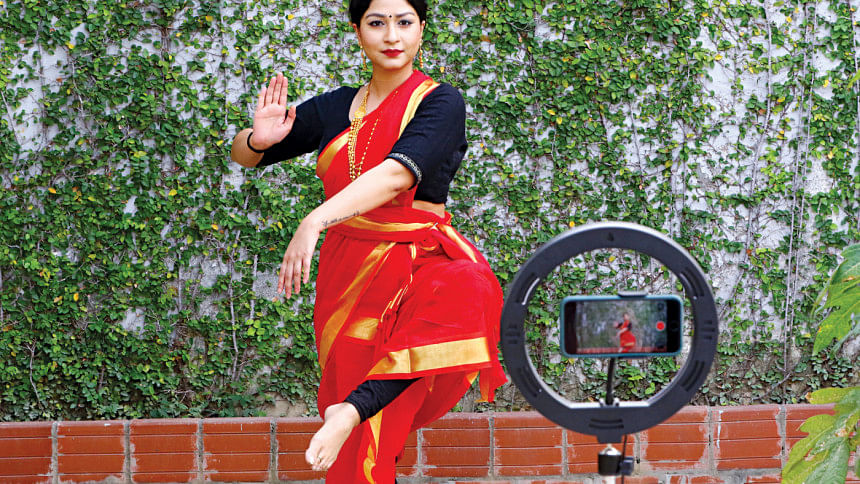Have digital platforms changed the rhythm of dance?

Dance, being a physical art form, is visually stunning, especially when presented on stage. However, owing to the coronavirus pandemic, institutionalised dance in Bangladesh had to embrace online platforms to sustain.
While challenges are inevitable during any transition, many positive changes were also discovered during this time by professional dancers.
The Daily Star spoke to four prominent dancers, who are not only performers, but also choreographers and teachers, about the merits and demerits of this digital shift.

At the start of the pandemic, most dance institutions felt challenged by the switch to online platforms.
"We are still struggling. However, with time, we have learned to use technology to ensure our livelihoods," shares Ekushey Padak-winning dancer, activist, and co-founder of Nrityanchal Dance Company, Shamim Ara Nipa. "It was not easy, but we have learnt to swim across this perilous ocean."
She also emphasises on the benefits brought about by this change:
"The dancers adapted to the digital methods within a few days of the first lockdown, which worked wonders in the weeks that followed. We all helped each other, and collaborated on awareness-raising initiatives. We motivated artistes to keep up their mental strength, through institutional and personal initiatives. These stressful times brought us together at a united front."
Nrityanchal began to conduct online classes midway through 2020.
"Our audience and colleagues, especially from print and online media, supported us in terms of circulating our messages. Social media worked wonderfully in our favour," adds Shamim Ara Nipa.
Renowned Manipuri exponent and founder of well-known dance institution, Nritya Nandan Sharmila Banerjee shares her experiences, in line with that thought. "Through social media, we connected to dancers around the world. Platforms like Zoom and Google Meet aided the process through webinars, online discussions, and many more such interactive activities," she says.
"We all helped each other and collaborated on awareness-raising initiatives. We motivated artistes to keep up their mental strength, through institutional and personal initiatives."
Her students and their parents have been content with online teaching. "Dance relies on practice and practicality, so we are accustomed to the face-to-face teaching and learning pedagogy," she says. "However, with the emergence of online classes, we broke out of that mentality. This change has also equipped parents and students with more digital efficiency." Nritya Nandan switched to online classes in full swing in March 2020.
Sharmila Banerjee also teaches Manipuri dance at Chhayanaut.
"We were not just successful in conducting online classes at Chhayanaut, but we also facilitated online exams to avoid session jams," she adds, attesting that both teachers and students have now become accustomed to the screens.
The pandemic also pushed dance teachers to create audio-visual archives for their students, which has been helpful in terms of preserving the theoretical knowledge of dance.
"Children are able to reflect upon their own performances by comparing their movements with the recorded demonstrations that we provide after each lesson," shares Sharmila Banerjee.
Shadhona - A Center for Advancement of Southasian Culture organised their production, "Bakshobondhi Boisakh", virtually. It was the first online production by a dance institution after the pandemic hit the country.
Prominent dancer Arthy Ahmed, Director of Strategy and Marketing at Shadhona, shares that the break gave dancers some breathing space as they were able to put their regular routines on hold for a bit to focus on restoring their mental well-being, before returning to their craft.
"Our teachers, trainers, and performers were already familiar with online classes, as we have teachers, researchers, and professors from all over the world facilitating our sessions," she adds.
"We got our students used to the online practices within the last week of March in 2020."
Alongside classes, stage shows were organised online, featuring many performances. But as Arthy Ahmed mentions, problems arose when it came to ensuring remuneration, because organisers seemed to be ignorant about the fact that, be it online or offline, a dance performance requires effort.
Arranging sponsors was a challenge for online shows. "Most sponsors went to social welfare organisations, as those were better for their brand image," shares Arthy Ahmed. "However, we were also struggling to sustain."
Being available online worked in both positive and negative ways for dancers.
"While several dancers who were outside Dhaka were able to get work that helped their careers, many ended up losing the auditorium-going audience. They shared their performances online, but people were just not interested in them as they preferred fresh, live performances," adds Arthy Ahmed.

Furthermore, getting familiar with the different functions of online platforms and being able to deal with technology smoothly with good internet speed was difficult for renowned Kathak exponent and founder of Rewaz Performers School Munmun Ahmed, initially.
"We never gave much importance to things like camera positioning or light play before, because we only had to pose for the stage, but with the emergence of online classes, we now have a better sense of handling modern equipment," she adds.
Students help each other out, and the virtual screens act as tools for them to monitor their own performances during classes, notes Munmun Ahmed.
"We have limited resources and very few Kathak dance festivals," she adds. "However, now, we can participate in different international events, easily showcasing our rising talents, achievements, and creations to a global audience."
With time, dancers have embraced this digital shift, trying their best to stay connected to their craft while hoping for a better tomorrow.
Model: Naziba Basher
The author is Reporter, Arts & Entertainment, The Daily Star.
Email: [email protected]

 For all latest news, follow The Daily Star's Google News channel.
For all latest news, follow The Daily Star's Google News channel. 



Comments